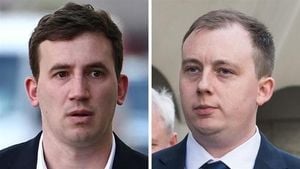Stanley Druckenmiller, widely regarded as one of the best investors ever, is at it again, and this time he’s taking the bold step of betting against the Federal Reserve’s outlook on interest rates and inflation. For decades, Druckenmiller's Duquesne Capital Management delivered impressive returns, averaging 30% annually for thirty years, outpacing even Warren Buffett's performance with Berkshire Hathaway. Although Duquesne Capital closed its doors back in 2010, Druckenmiller continues to make waves through his Duquesne Family Office. Rumors have emerged from recent conferences where Druckenmiller shared his views, questioning whether he might know something the rest of Wall Street has missed.
Currently, the prevailing sentiment among the market and the Fed leans toward the belief inflation will cool down and interest rates will continue their downward trend. According to the CME Group’s FedWatch tool, traders expect the Fed to lower rates by about 50 basis points by the end of this year and aim for rates between 3.25% to 3.50% by the end of 2025. This expectation aligns with the Federal Open Market Committee’s regular updates—often referred to as the “dot plot”—which reflects the anticipated path of interest rates as perceived by the committee members. The Fed is striving for what it calls a "soft landing," where inflation declines back to its goal of 2% without pushing the economy toward recession.
Against this backdrop, Druckenmiller is making his play by shorting U.S. Treasury bonds. Reports from the conference reveal this strategy accounts for approximately 15% to 20% of his investment portfolio. A short position on Treasury bonds is primarily based on expectations of rising yields, which would happen if bond prices fall. Druckenmiller’s wager indicates he believes inflation could not only linger but potentially reach levels reminiscent of the 1970s. If inflation spikes, the Fed might be unable to cut rates as much as the market expects or even at all if the economy heats up.
But how deep Druckenmiller's bet goes remains unclear. For investors, the duration of the bonds he’s shorting matters. The ramifications differ drastically between shorting two-year bonds compared to thirty-year ones. He also expressed uncertainty about how long his trade will take to come to fruition—whether it’s six months or six years is anyone’s guess. Druckenmiller raised concerns about the “bipartisan fiscal recklessness” occurring with conservative and liberal parties alike pushing for expansive government expenditure.
This talk around fiscal health and rising debt levels resonates with broader economic themes. When the national debt increases, or the market becomes concerned about the government’s capability to finance its debt, investors can demand higher interest rates, which causes bond prices to drop.
Recent events have also stirred discussions around the economic outlook for the U.S., particularly the notion of a “no landing” scenario which entails strong economic performance coupled with inflation exceeding the Fed’s targets. This hypothesis emerged markedly over the past month as macroeconomic data showed surprising strength. Major institutions, like Bank of America and UBS, have noted the increasing probability of this scenario where U.S. economic growth remains above expectations, keeping inflation elevated and dampening hopes for aggressive rate cuts from the Fed.
Just last month, the job market surprised many with September’s job figures evidencing the creation of 254,000 new roles and pushing the unemployment rate down to 4.1%. The GDP reports have also shown positive revisions. With these developments, the narrative shifts from worrying about downturns to discussing potential growth surges.
The effects on investment strategies are substantial, as analysts suggest leaning more toward equities—especially those with high dividend yields—in response to the 'no landing' scenario. Jamie Cox of Harris Financial Group suggests transitioning expectations. He anticipates short-term interest rates dropping to around 3% under this scenario, prompting investors away from money markets and T-bills back toward equities.
Meanwhile, inflation worries loom large, with the September Consumer Price Index rising to 2.4%, pushing down expectations of any aggressive interest rate cuts. According to Cox, not only will the Fed not cut rates as drastically as predicted, but this could also add room for sectors such as utilities, staples, and telecom to benefit—those typically seen as havens when economic climates change.
The looming meetings of the Federal Open Market Committee on November 6 and 7 will not only seek to weigh these growing pressures but will also look to stabilize the job market and inflation concerns. The conversation around whether the Fed will cut rates again is gripping, especially after their previous cut last month marked the first reduction since 2020. The surprising strength of the job market juxtaposed against rising inflation rates leaves many economic analysts pondering the true direction of the U.S. economy.
Reflections on Jerome Powell’s leadership as Fed Chair come under scrutiny as his record reflects the nuanced balance between managing inflation and fostering employment stability. Critics argue his delayed response to curbing inflation led to distorted market conditions and asset bubbles, particularly within the housing market.
Despite the Fed's efforts to engineer favorable conditions for both inflation reduction and job growth, the realities of economic policy reveal themselves to be precarious. Chris Zaccarelli, CIO for Independent Advisor Alliance, highlights the complex nature of the data. If inflation proves higher than expected—and with the recent uptick, it likely will—the Fed might find itself reverting to cautious measures, curtailing any immediate rate cuts.
The federal decisions made this coming November will be consequential. The last time the Fed cut rates without sparking recessions was quite rare, and if it were to happen again this time around, historical precedents suggest strong market equity growth may follow. The tension between managing inflation and nurturing job growth is palpable, and how the Federal Reserve navigates this will soon be made clear.
At this crossroads of potential economic scenarios, investor sentiment remains cautious but optimistic. The dynamics of policy and performance on these fronts will chiefly dictate where markets go from here. For now, all eyes remain on the data and the insights from influential figures like Druckenmiller, as the Fed's next moves are likely to dictate the broader trend of the economy moving forward.



